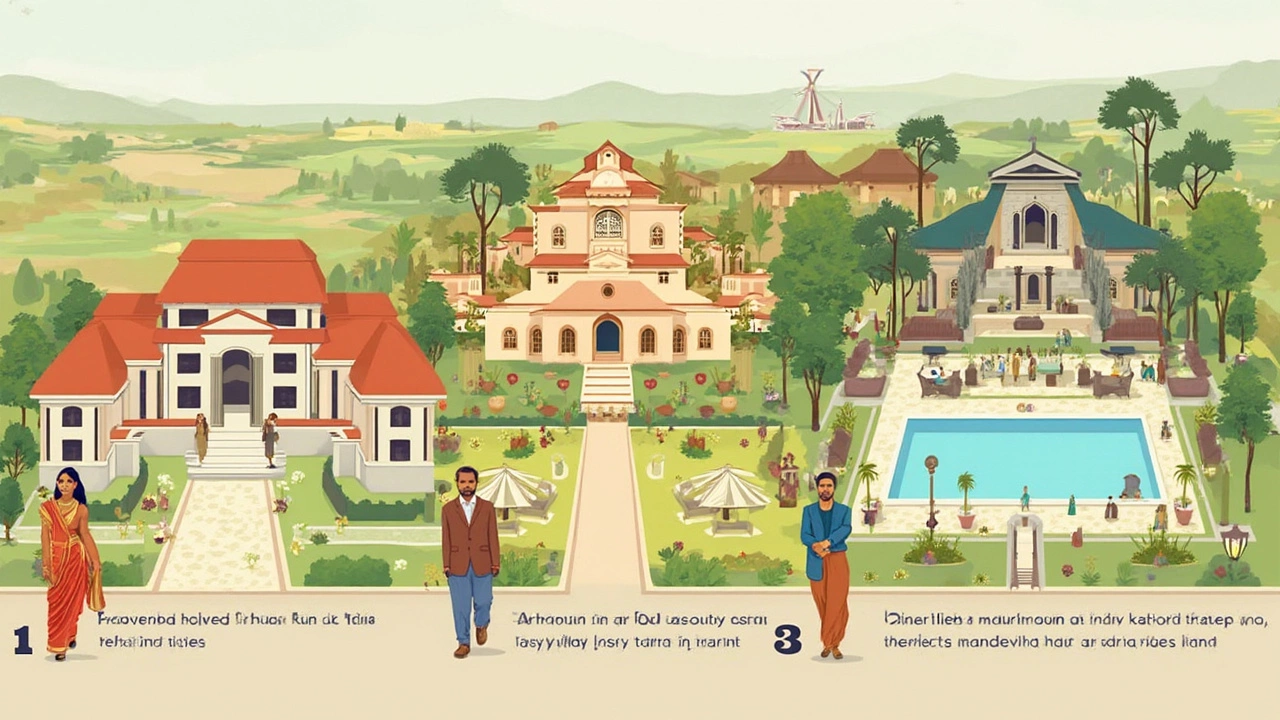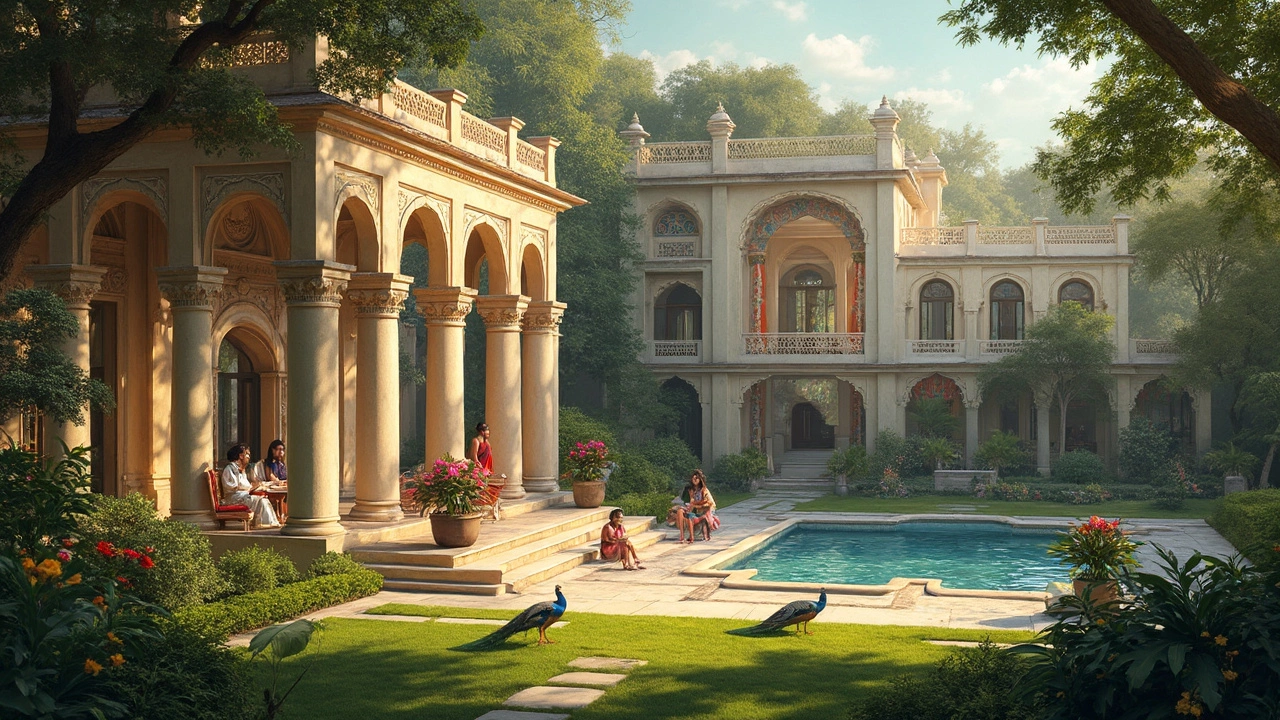Most people picture a shiny pool, a big garden, and space for days when they hear “villa.” But why call it a villa? Is it just a fancier word for a house, or is there more behind it?
The word goes way back—like, ancient Rome back. Roman villas were actually country houses owned by the rich. These places weren’t vacation rentals; they were full-on estates with farms, gardens, and sometimes even their own bathhouses. If you had a villa, you’d probably made it big.
Funny thing, today’s “villa” for sale doesn’t always look much like those Roman hideouts. But the idea stuck: a place just outside the busy city, linked to comfort, nature, and a bit of luxury. Next time you see a “villa” on the market, it might help to remember it once meant you were basically Roman royalty.
- The Ancient Roots of the Word 'Villa'
- How Villas Changed Through Time
- What Makes a Home a Villa Today
- Tips for Buying a Villa: What to Watch Out For
The Ancient Roots of the Word 'Villa'
If you trace the word “villa” back, you land right in the middle of ancient Rome. Back then, a villa wasn’t a house in the suburbs—it was a mega property. Roman families who struck it rich would build these sprawling homes in the countryside to get away from the noisy, crowded cities.
The original Latin word was also “villa,” and it simply meant a farm or a country house. But not just any farm—a Roman villa came with big land, separate buildings for workers, and sometimes even working vineyards or olive groves. These places were almost like little villages under one owner’s name, run like well-oiled machines.
| Feature | Roman Villa | Modern Villa |
|---|---|---|
| Location | Countryside outside Rome | Suburbs, resorts, countryside or by the coast |
| Main Use | Agriculture, retreat for the rich | Leisure, luxury living |
| Common Features | Farms, gardens, staff quarters | Pools, gardens, privacy |
The cool part? A Roman historian named Pliny the Younger actually detailed his villas and garden layouts, showing how carefully these places were planned. He described, “the charm of the coast and the retreat of the countryside” (quoted from his letters, around 100 AD):
The villa embraces the sea, the shore, the mountains—nothing is missing, only the noise of the city.
Fast forward a bit, and the word “villa” starts popping up all over Europe, but it always means more than just a regular house. It’s all about comfort, escape, land, and a touch of style even 2,000 years ago. These roots are why listings for ‘villas for sale’ still carry that sense of luxury and exclusiveness today.
How Villas Changed Through Time
Villas have seriously transformed since their Roman days. Back then, only wealthy landowners built these places, far away from the city noise, mainly for relaxation and farming. Fast forward to the Middle Ages, and the idea of a villa started to change. In places like Italy and Spain, villas were still about status, but now more folks owned them, sometimes as working farms, sometimes just as comfortable countryside homes.
By the Renaissance, villas got even fancier. Italian artists and architects turned them into showpieces—picture manicured gardens, grand courtyards, and frescoes on the ceilings. They became summer spots for city people who wanted to escape the heat and crowds. French and British elites didn't want to miss out, so they borrowed the idea, too.
Jumping to the 19th and 20th centuries, the meaning of villa widened a lot. In places like England, "villa" started popping up in city suburbs. These were smaller, detached houses for families who wanted space and fresh air—not just aristocrats. After World War II, the villa idea exploded, especially in tourist areas. Spain's Costa del Sol or the South of France? Tons of “villas” started getting built for regular buyers and holidaymakers.
Now, you'll spot villas everywhere—from Bali to Florida. The word “villa” paints a picture of privacy, comfort, and maybe a pool, but the actual style and size can be wildly different depending on the country.
| Time Period | Key Villa Features | Who Owned Them |
|---|---|---|
| Roman Times | Farms, gardens, estate buildings | Rich landowners |
| Middle Ages | Countryside homes, farmland | Nobility, upper middle class |
| Renaissance | Ornate details, large gardens | Artists, city elite |
| Modern Era | Private space, modern amenities | Families, vacationers |
So, why does all this matter if you're hunting for villas for sale? Knowing a bit of history makes it easier to find what you actually want. Some places use "villa" for compact suburban homes, others for sprawling estates. Always check what’s included before you fall for a fancy listing photo.

What Makes a Home a Villa Today
The word 'villa' gets tossed around in real estate ads, but there are a few things that set a true villa apart from just any house. Modern villas usually tick off specific boxes that make them appealing to buyers who want comfort, style, and room to breathe.
First off, space matters. A villa often means more square footage, both inside and outside. It’s not just a cramped apartment with a fancy label. You’ll likely find at least three bedrooms, big living areas, and a private garden or patio. Private pools aren’t rare either—especially in places where the sun’s out most of the year.
Another key thing: privacy. Most villas stand on their own land, not sandwiched between other buildings. You get your own entrance, your own yard, and nobody walking by your window at all hours. If you hate sharing lifts or halls, a villa could be your dream.
- Standalone building on its own plot
- Private outdoor space (garden, pool, patio)
- Multiple bedrooms and living areas
- Upscale finishes and modern amenities
- Security—think gates, fences, or even a guard in some communities
Some places, like Spain or Dubai, actually set clear standards for what counts as a villa when they list villas for sale. For example, Dubai’s developers often require at least 2,000 square feet of built-up area and a private yard. In Spain’s Costa del Sol, buyers expect separate parking and swimming pools as standard, not upgrades.
| Feature | Typical Villa | Standard Apartment |
|---|---|---|
| Private plot | Yes | No |
| Outdoor area | Yes | Often shared |
| Bedrooms | 3 or more | 1-2 |
| Pool | Usually private | Sometimes shared |
| Security | High | Medium |
So, if you’re browsing listings and you see "villa," check what’s really on offer. It’s about more than just the size or the location—it’s the comfort, privacy, and lifestyle that come with the package.
Tips for Buying a Villa: What to Watch Out For
So, you’re thinking about buying a villa. Sure, they look amazing in photos, but real life can be a little more complicated. Let’s talk about what you need to know so you don’t get caught out or miss a trick when checking out villas for sale.
- Location matters. It’s not just the view. Check if the villa is near schools, hospitals, and stores. If it’s a vacation home, make sure you know the season—it can be super busy or totally empty at different times.
- Ask about the builder. Some developers are known for good work; others cut corners. Google the name, ask locals, or look for honest reviews.
- Don’t forget maintenance fees. Villas might come with private pools or gardens, but someone has to keep them running. Ask for a list of monthly or yearly costs up front.
- Security is a big deal. Many villas, especially gated ones, offer security 24/7, but rules and services vary. Find out what’s actually included—no point paying for something you don’t get.
- Check the paperwork. Make sure everything is clear, from ownership documents to taxes. If you’re buying abroad, double-check if foreigners are allowed to buy property in that area.
Here’s a look at some typical costs you might see with villas compared to other property types:
| Type | Average Maintenance Fee (per month) | Security Services | Garden/Pool Upkeep |
|---|---|---|---|
| Villa | $300 - $800 | Gated, 24/7 or Limited | Yes (usually required) |
| Apartment | $100 - $300 | Building entry only | No |
| Townhouse | $200 - $500 | Community-wide | Maybe (shared or small) |
One thing that trips up a lot of buyers is zoning and legal stuff. Is the villa approved for residential use? Are there building restrictions in the area, like no pools or limits on how tall you can build? A quick check with your local property office can save you serious headaches.
If you want to use the villa as a rental or for AirBnB, find out if that’s even allowed. Some fancy villa communities have strict rules about short-term rentals.
Bottom line, don’t let shiny photos or a good view distract you. Ask the tough questions and look for hard facts. This way, you’ll find a villa that matches your dream—and keeps your wallet safe too.







Write a comment